
THE SHADOW
Old Time Radio 3 CD-ROM - 251 mp3 - Total Playtime: 115:06:02
DELIVERED IN A PLASTIC BOX-SET
The Shadow was
long believed to have debuted on radio as a program
in its own right September 26, 1937, on the Mutual
Broadcasting System. But the character actually
premiered in September 1931, on CBS, as part of the
hour-long The Blue Coal Radio Revue (named for the
show's sponsor), featuring Frank Readick -- the
"Shadow" announcer of Detective Stories -- as The
Shadow, and playing Sundays at 5:30 p.m. Eastern
Standard Time. The stories also appeared on Thursday
nights for a month, when Love Story Drama (another
Street and Smith creation) took the Thursday night
slot -- but also featured occasional portrayals of
The Shadow.
Blue Coal had a long relationship with the Shadow,
moving the radio series to NBC in October 1932 with
Readick playing the character on Wednesday nights
now. Two years later, NBC ran the stories on Mondays
and Wednesdays, both at 6:30 p.m., with LaCurto
taking occasional turns as the title character.
Three years later came the beginning of the
half-hour drama radio buffs have remembered so well,
with the then-unknown Orson Welles as The Shadow, the
show moving to Mutual, and the famous catch phrase
now in full play accompanied by the strains of an
excerpt from Opus 31 of the Camille Saint-Saëns
classical composition, "Le Rouet d'Omphale".
the then-unknown Orson Welles as The Shadow, the
show moving to Mutual, and the famous catch phrase
now in full play accompanied by the strains of an
excerpt from Opus 31 of the Camille Saint-Saëns
classical composition, "Le Rouet d'Omphale".
Welles did not speak that signature line -- Readick
did, using a water glass next to his mouth for the
echo effect. But Welles did make a credible Shadow,
two years before his notoriety as the mastermind of
Mercury Theatre on the Air's production of War of
the Worlds.
After Welles left the role for a career in the
cinema, The Shadow was portrayed by such actors as
Bill Johnstone, Bret Morrison (the longest tenure,
with ten years in two separate runs), John Archer,
and Steve Courtleigh as Lamont Cranston/The Shadow.
The radio show also introduced female characters
into the Shadow's realm, most notably Margot Lane
(played by Agnes Moorehead among others) as
Cranston's love interest and crime-solving partner
(the character was eventually integrated into
Gibson's pulp novels). Lane was described as
Cranston's "friend and companion" in later episodes,
although the exact nature of their relationshp was
left unclear. In the 1994 movie, Margot's name was
spelled "Margo." However, early scripts of the radio
show clearly show that the character's name was
spelled "Margot".
Once The Shadow joined Mutual as a half-hour series,
it did not leave Sunday evenings radio until
December 26, 1954, outlasting the magazine that gave
birth to it: The Shadow Magazine ended with the
summer 1949 issue, although Gibson wrote three new
"official" stories between 1963 and 1980. Gibson
started off a short series of updated Shadow novels
for Belmont with Return of the Shadow under his own
name, followed by The Shadow Strikes, Beware Shadow,
Cry Shadow, The Shadow's Revenge, Mark of The
Shadow, Shadow Go Mad, Night of The Shadow, and
Destination: Moon. The Shadow had mental powers in
these books, to cloud men's minds so he effectively
became invisible, to conquer pain, etc.
Be
Aware: MP3 CD WILL NOT PLAY IN REGULAR CD PLAYERS.
Mp3 CD will play in mp3 CD players and car mp3 CD players.
You can, also, upload the mp3 files to your ipod or itunes.
Will, also, play in your computer, some regular DVD players
and all Blu Ray Players.

PUBLIC DOMAIN NOTE
This item is the public domain and was created between January 1, 1923 and
December 31, 1971
This item is in the public domain due to failure to comply with required
formalities
After a careful search of the Library of Congress and the United States
Trademark and Patent Office, it has been determined that the programs listed
for sale here are in the Public Domain. They are being offered with the
understanding that no valid or active copyright, trademark, and/or patent
exist for them. These recordings are sold for private home listening and use
only. No broadcast rights are stated, implied, or given. I assume no
responsibility for unauthorized use of these programs. They are listed in
accordance with current policies concerning selling Public Domain
materials.
